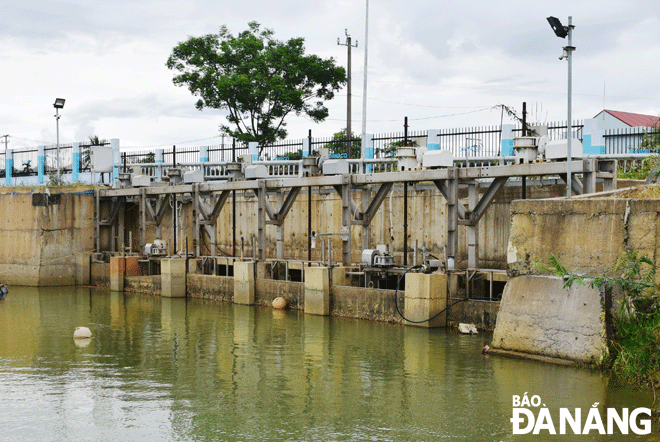Scientific and technological applications in natural disaster prevention, mitigation
Da Nang has gradually transformed digitally, applied science, technology, and databases into reality, especially in releasing forecast, alerts and warnings against such natural disasters such as floods and landslides.
 |
| Automatic salinity monitoring data and a control system for collecting fresh water on the river surface will be integrated into the ENSURE Da Nang Centre project for convenient command and control in the future. Photo: HOANG HIEP |
Every time the National Centre for Hydro-meteorological Forecasting releases a bulletin predicting the updated tracks and developments of storms that are likely to affect Da Nang, the Office of the city’s Steering Committee for Disaster Prevention, Search and Rescue and Civil Defence easily grasps the number of households and people that need to be evacuated to safety corresponding to the storm wind scales.
Similarly, whenever there is a flood forecast and warning, local authorities also immediately list the number of households whose houses are flooded or need to be evacuated to safety, depending each flood warning level.
In particular, the city’s Steering Committee for Disaster Prevention, Search and Rescue and Civil Defence has coordinated with the Mid-Central Region Centre for Hydro-meteorological Forecast to install water level measurement stations on Tuy Loan and Cu De rivers to serve flood forecasting and warnings, especially flash flood alerts.
Notably, Da Nang-based Water Resources Development and Consulting Company (WATEC) has completed the installation of 21 rainfall monitoring systems and automatically updated rainfall to the Vrain, the largest automatic rain gauge device in Viet Nam, at www.vrain.vn.
Vrain provides early flood warnings and monitor reservoir operations, hereby strengthening local capacity to anticipate, prepare for, cope with and respond more effectively to disasters. Vrain itself allows both the local authorities and residents to monitor the actual real- time rainfall pouring down onto a unit area.
This easy-to-use and reasonably-priced automatic system features high quality automatic rainfall measuring equipment and software. It also shows off more advantages as compared to manual rain gauges as rainfall data are transferred automatically to the real-time management system.
Meanwhile, manual rain gauges are a simple tube, closed on one end and calibrated in inches to indicate the amount of liquid.
Since 2019, WATEC has cooperates with the Steering Committee for Disaster Prevention, Search and Rescue and Civil Defence to pilot two automatic flood alert systems in Hoa Vang District.
In detail, one placed on the Dong Nghe Lake will automatically operate when the lake is overflowing due to an excessive amount of rainwater, hereby giving flood warnings through a loudspeaker to warn people travelling from downstream areas not to enter flooded drainage ditches. The other at the culvert spillways will release light signals and warnings through the speaker systems placed at both ends of a road when floodwater flows over the road surface.
Through floods happening in 2019, 2020 and heavy rains in 2021, the aforementioned systems have operated effectively, giving early warnings to people to proactively respond to the arrival of flood.
In particular, the automatic flood alert systems are based on the IoT application with LoRa (short for long range) technology. Rain sensors, water level gauges and warning devices are wirelessly connected and broadcast alerts at pre-set levels in flooded areas without being dependent on telecommunications networks.
In addition, the control devices are connected to the management platform via 3G and 4G, thereby allowing data to be retrieved on system operation and flood status via the internet.
More recently, Da Nang, in collaboration with the Korean International Cooperation Agency (KOICA), has kicked-start the Integrated Centre for Controlling Green and Smart Urban Resilience Project (ENSURE Centre) in this central Vietnamese city.
The project, which is expected to be complete in 2025, will cover a total investment of VND259.3 billion, of which the non-refundable ODA from the Government of the Republic of Korea (RoK) government through KOICA is more than VND246.8 billion and the rest is from the Da Nang budget’s reciprocal capital.
Once operational, the ENSURE Da Nang Centre will be the first role model in Viet Nam with various functions of integration of emergency calls, information sharing between emergency response agencies (police, firefighting, health care, civil service), disaster monitoring through hi-tech systems, and the provision of disaster response scenarios, and training on disaster response.
Through the ENSURE Centre project, Da Nang aims to early recognise and warn of natural disasters, forecast their developments, improve the capacity of its disaster forecast and response, provide timely and accurate information and notifications to the community for active prevention, and promote green urban restoration.
In the face of climate change and the increasingly serious effects caused by natural disasters, the ENSURE Centre is particularly important for Da Nang, and the whole central region at large.
Also, the project helps Da Nang reach its ambitious target of becoming into a smart city by 2030 synchronously connecting with the network of smart cities in the country and in the ASEAN region.
Reporting by HOANG HIEP – Translating by A.THU